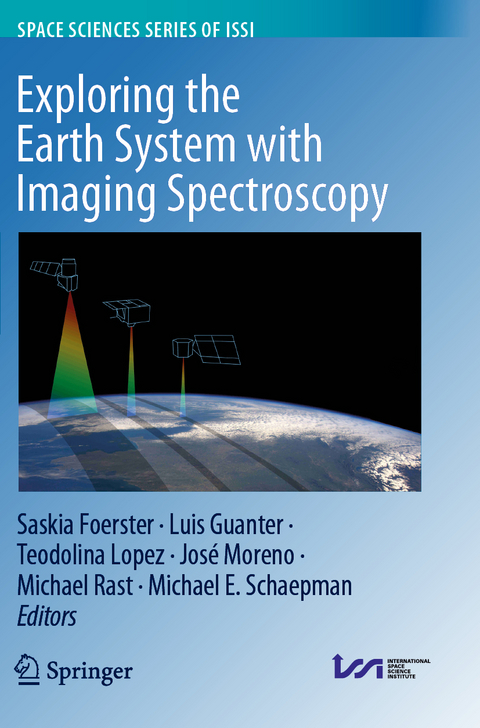
Exploring the Earth System with Imaging Spectroscopy
Springer International Publishing (Verlag)
978-3-030-24912-0 (ISBN)
Previously published in Surveys in Geophysics, Volume 40, Issue 3, 2019
The chapters "Imaging Spectrometry of Inland and Coastal Waters: State of the Art, Achievements and Perspectives", "Imaging Spectroscopy for the Detection, Assessment and Monitoring of Natural and Anthropogenic Hazards", "Assessing Vegetation Function with Imaging Spectroscopy", "Spaceborne Imaging Spectroscopy for Sustainable Agriculture: Contributions and Challenges" are available as open access articles under a CC BY 4.0 license at link.springer.com.
lt;p>Saskia Foerster holds a senior scientist position in the Remote Sensing Section at the Helmholtz Centre Potsdam, German Research Centre for Geosciences (GFZ) in Potsdam/Germany. Her research interests include the monitoring of soil and land degradation processes, water resources and natural hazards using multi-sensor Earth observation data. Furthermore, she has been working in the scientific preparation of the German space-borne imaging spectroscopy mission EnMAP for the past ten years.
Teodolina Lopez holds an Earth Science post-doctoral position at the International Space Science Institute (ISSI) in Bern, Switzerland. Her research focuses on the characterisation in (semi-) arid regions of the groundwater flow and transfers and their interaction with the atmosphere. This approach relies on the synergy between Earth Observation dataset (mostly thermal infrared and gravity) with in situ measurements (geophysical, geochemical and geology) and simulations.Michael E. Schaepman is professor of remote sensing at the University of Zurich, Switzerland. His research focus is on optical remote sensing, in particular quantifying light-matter interactions using forward and inverse radiative transfer models. His current projects are related to developing trait-based approaches to observing functional diversity from regional to global scale using air- and spaceborne satellite missions. He further contributes to assessing genetic mechanisms underlying the behavior of plants in their natural environment by linking genomics, phenomics and spectranomics at different spatial and temporal scales using remote sensing.
Luis Guanter obtained his Ph.D. in Environmental Physics in 2007 from the University of Valencia, Spain. In the last years he has been the Head of the Remote Sensing Section of the GFZ Potsdam and the Principal Investigator of the EnMAP spaceborne imaging spectroscopy mission. His research is focused on the remote sensing of the Earth's surface and atmosphere with space- and airborne sensors. He has moved recently to a new position as a Professor of Applied Physics at the Universitat Politècnica de València.
Jose Moreno is Professor of Earth Physics with the Department of Earth Physics and Thermodynamics, Faculty of Physics, University of Valencia, Spain, and director of the Laboratory for Earth Observation (LEO) Image Processing Laboratory/Scientific Park. His main work is related to the modeling and monitoring of land surface processes by using remote sensing techniques. He has been involved in the preparatory activities and exploitation programs of several imaging spectroscopy satellite missions (SPECTRA, CHRIS-PROBA), member of the HyspIRI International Science Group, member of the EnMAP Science Advisory Group, and chairman of the Mission Advisory Group for the ESA Earth Explorer FLEX (Fluorescence Explorer) mission.
Michael Rast followed studies in geology / geo-scientific remote sensing. He joined ESA, mainly involved in establishing mission/science requirements for Earth observation satellite sensors, e.g. MERIS on Envisat. Following a research year at NASA's JPL, he obtained a doctorate at the University of Munich in imaging spectroscopy. After a secondment to the GEO Secretariat, Geneva as Senior Programme Officer, he headed the Earth Observation Science Strategy Office at ESA-ESRIN until 2017, when he became the Senior Advisor to the Director of Earth Observation Programmes. He holds a professorship for terrestrial remote sensing at the Department for Geography of the Ludwig-Maximilians University, Munich.
Guest Editorial: International Space Science Institute (ISSI) Workshop on Space-Borne Imaging Spectroscopy for Exploring the Earth's Ecosystems.- Earth Observation Imaging Spectroscopy for Terrestrial Systems: An Overview of Its History, Techniques, and Applications of Its Missions.- Retrieval of Atmospheric Parameters and Surface Reflectance from Visible and Shortwave Infrared Imaging Spectroscopy Data.- Imaging Spectroscopy for Soil Mapping and Monitoring.- Imaging Spectrometry of Inland and Coastal Waters: State of the Art, Achievements and Perspectives.- Imaging Spectroscopy for the Detection, Assessment and Monitoring of Natural and Anthropogenic Hazards.- Imaging Spectroscopy of Urban Environments.- Assessing Vegetation Function with Imaging Spectroscopy.- Spaceborne Imaging Spectroscopy for Sustainable Agriculture: Contributions and Challenges.- Imaging Spectroscopy of Forest Ecosystems: Perspectives forthe Use of Space-borne Hyperspectral Earth Observation Systems.- Quantifying Vegetation Biophysical Variables from Imaging Spectroscopy Data: A Review on Retrieval Methods.- Variability and Uncertainty Challenges in Scaling Imaging Spectroscopy Retrievals and Validations from Leaves Up to Vegetation Canopies.- Synergies of Spaceborne Imaging Spectroscopy with Other Remote Sensing Approaches.
| Erscheinungsdatum | 05.09.2020 |
|---|---|
| Reihe/Serie | Space Sciences Series of ISSI |
| Zusatzinfo | VI, 391 p. 96 illus., 79 illus. in color. |
| Verlagsort | Cham |
| Sprache | englisch |
| Maße | 155 x 235 mm |
| Gewicht | 720 g |
| Themenwelt | Naturwissenschaften ► Geowissenschaften ► Geografie / Kartografie |
| Naturwissenschaften ► Geowissenschaften ► Geologie | |
| Technik ► Umwelttechnik / Biotechnologie | |
| Schlagworte | Earth observation • Hyperspectral Remote Sensing • Imaging Spectroscopy • Remote Sensing/Photogrammetry • spaceborne missions • Terrestrial Ecosystems |
| ISBN-10 | 3-030-24912-3 / 3030249123 |
| ISBN-13 | 978-3-030-24912-0 / 9783030249120 |
| Zustand | Neuware |
| Informationen gemäß Produktsicherheitsverordnung (GPSR) | |
| Haben Sie eine Frage zum Produkt? |
aus dem Bereich


